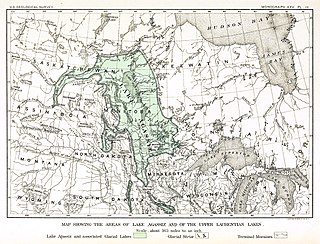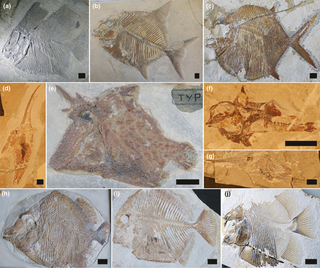
Jean Louis Rodolphe Agassiz FRS (For) FRSE was a Swiss-born American biologist and geologist who is recognized as a scholar of Earth's natural history.

Lake Agassiz was a large proglacial lake that existed in central North America during late Pleistocene, fed by meltwater from the retreating Laurentide Ice Sheet at the end of the last glacial period. At its peak, the lake's area was larger than all of the modern Great Lakes combined.

Semionotiformes is an order of ray-finned fish known from the Middle Triassic (Anisian) to the Late Cretaceous (Maastrichtian). Their closest living relatives are gars (Lepisosteidae), with both groups belonging to the clade Ginglymodi within the Holostei. The group includes both freshwater (Semionotidae) and marine adapted forms. Many members of the family Macrosemiidae, have elongated dorsal fins, often associated with an adjacent area of skin which was free of scales. These fins were likely undulated for use in precision swimming. The body morphology of macrosemiids suggests that they were slow swimmers that were capable of maneuvering around complex topography, such as reef environments.

Elizabeth Cabot Cary Agassiz was an American educator, naturalist, writer, and the co-founder and first president of Radcliffe College. A researcher of natural history, she was an author and illustrator of natural history texts as well as a co-author of natural history texts with her husband, Louis Agassiz, and her stepson Alexander Agassiz.

Samuel Hubbard Scudder was an American entomologist and paleontologist. He was a leading figure in entomology during his lifetime and the founder of insect paleontology in America. In addition to fossil insects, he was an authority on butterflies (Lepidoptera) and grasshoppers (Orthoptera).
Henry Bryant Bigelow was an American oceanographer and marine biologist.

Cidaris is a genus of pencil sea urchins.

Warren Upham was an American geologist, archaeologist, and librarian who is best known for his studies of glacial Lake Agassiz.

Carcharias is a genus of mackerel sharks belonging to the family Odontaspididae. Once bearing many prehistoric species, all have gone extinct with the exception of the critically endangered sand tiger shark.

Mount Agassiz, at 13,899 feet (4,236 m), is one of the 20 highest peaks of California. It is the northernmost and easiest to climb of the major Palisades summits. This peak is not to be confused with the 9,967-foot (3,038 m) peak by the same name in Desolation Wilderness, also in the California Sierra.

Pycnodontiformes is an extinct order of primarily marine bony fish. The group first appeared during the Late Triassic and disappeared during the Eocene. The group has been found in rock formations in Africa, Asia, Europe, North and South America. They were small to middle-sized fish, generally with laterally-compressed deep bodies, some with almost circular outlines, adapted for manuverability in reef-like environments, though the group was morphologically diverse. Most, but not all members of the groups had jaws with round and flattened teeth, well adapted to crush food items (durophagy), such as echinoderms, crustaceans and molluscs. Some pyncodontiformes developed piranha like teeth used for eating flesh. Most species inhabited shallow marine reef environments, while a handful of species lived in freshwater or brackish conditions. While rare during the Triassic and Early-Middle Jurassic, Pycnodontiformes became abundant and diverse during the Late Jurassic, exhibiting a high but relatively static diversity during the Early Cretaceous. At the beginning of the Late Cretaceous they reached their apex of morphological and species diversity, after which they began to gradually decline, with a more sudden decline at the end of the Cretaceous due to the collapse of reef ecosystems, finally becoming extinct during the Eocene. They are considered to belong to the Neopterygii, but their relationship to other members of that group is uncertain.

Crossognathiformes is an extinct order of ray-finned fish that lived from the Late Jurassic to the Eocene. Its phylogenetic placement is disputed; some authors have recovered it as part of the teleost stem group, while others place it in a basal position within crown group Teleostei.

Holasteroida is an order of irregular sea urchins.

Filifera is a suborder of hydrozoans in the order Anthoathecata. They are found in marine, brackish and freshwater habitats.

Araeosoma is a genus of deep-sea sea urchins in the family Echinothuriidae.

Pauline Agassiz Shaw was an American philanthropist and social reformer who opened day nurseries, settlement houses, and other establishments in Boston to help new immigrants and the poor. She financed public kindergartens, and co-founded America's first trade school, the North Bennet Street School. She was also a vocal advocate for women's rights.

The pourtalesiids (Pourtalesiidae) are a family of irregular sea urchins that live in the deep sea. They are secondarily bilateral-symmetrical and like other representatives of the taxon Holasteroida they lack the lantern of Aristotle, which is typical for many other sea urchins. The genus Pourtalesia was named after Louis-François de Pourtalès who first collected these animals while dredging at a depth of 600 m. The family is known already from the Upper Cretaceous (Maastrichtian) and is distributed worldwide.

William David Barnes was an American entomologist and surgeon. He was the son of William A. and Eleanor Sawyer Barnes. He graduated from the Decatur High School in 1877. Then spent a year at Illinois State University followed by a year at University of Illinois at Urbana–Champaign. In 1879, he entered Harvard Medical School and graduated in 1886. While at Harvard, he met naturalist Louis Agassiz and his love of Lepidoptera grew. Agassiz taught him how to preserve and classify the butterflies. He completed an internship at Boston City Hospital and then studied abroad in Heidelberg, Munich, and Vienna. In 1890, Dr. Barnes came home to Decatur and opened his medical practice. That same year he married Charlotte L. Gillette. The couple had two children.

Aspidodiadema is a genus of echinoderms belonging to the family Aspidodiadematidae. The species of this genus are found in the Indo-Pacific and Caribbean.
Laodiceidae is a family of cnidarians belonging to the order Leptomedusae.

















